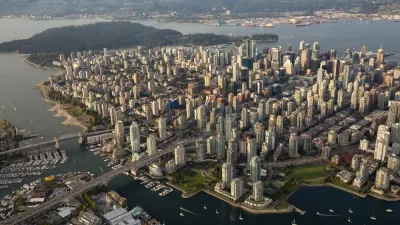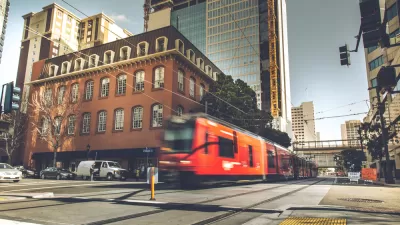The protesters at Chicago’s Grant Park in 1968 might have been talking about Denver’s multi-billion dollar FasTracks rail expansion while they chanted “the whole world is watching.” With 50+ new transit stations the Denver region has an opportunity no modern American city has been able to realize – to build a regional rail network and link it with land use planning to accommodate growth without diminishing livability. Part of the conversation in Denver is will FasTracks help the region’s competitiveness and capture more growth than it would otherwise? Or is the best planners can do is to use FasTracks as a tool to grow better by reshaping the growth that is already coming?
The protesters at Chicago's Grant Park in 1968 might have been talking about Denver's multi-billion dollar FasTracks rail expansion while they chanted "the whole world is watching." With 50+ new transit stations the Denver region has an opportunity no modern American city has been able to realize – to build a regional rail network and link it with land use planning to accommodate growth without diminishing livability.
Part of the conversation in Denver is will FasTracks help the region's competitiveness and capture more growth than it would otherwise? Or is the best planners can do is to use FasTracks as a tool to grow better by reshaping the growth that is already coming?
After 30 years pondering these questions I've seen no evidence to believe transit creates new growth in a region. There is lots of evidence that transit can redirect where and how growth occurs within a region in combination with supportive public policy. My hometown Portland, Oregon and parts of the Washington, DC region are well documented examples.
The question of induced growth seems to go to transit's impact on larger forces shaping growth in regions. Are regions rich in transit growing faster than they would have otherwise? Or are they simply growing better? For example, has the presence of 29 Metro stations within the District of Columbia caused the District to better compete for growth within the region? If transit induced growth one might expect a central city to be a magnet for growth. Since Metro opened growth in the 1970's the Washington Region has moved away from the core, not towards it. The District has recently turned the corner after decades of languishing. Transit's role in helping communities grow better can be seen just outside the District along Arlington County's Rosslyn Ballston Corridor. Since 1980 those five stations have captured 37% of new jobs and 25% of new housing in the county. Yet further flung places like Tysons Corner have captured much more growth with no transit. I'd certainly rather live in Arlington than Tysons, but is the transit rich DC region out performing transit poor Houston?
The last decade has seen record levels of transit expansion and more new investment around transit than anytime in recent history. Central cities are back in a big way (with and without transit). Yet everything I've seen out of Brookings and other observers of metropolitan trends seems to also indicate larger trends are underway that our cities are continuing to spread out and lose market share. If transit induced growth in a region wouldn't that counteract some of these trends? Or is the induced transit growth factor so small on a metropolitan scale it does not register in terms of broader trends?
If there was an argument for induced growth it might be as part of a "quality of life" package. I think you can argue that the complete package of transit and land use controls in Portland has helped to make it a desirable place to live and give the region a quality of life attraction. Of course the libertarians will passionately disagree. Does transit and land use make Portland grow faster than other western cities or simply growth differently?
If the Denver Region does not use transit as a growth shaping tool and simply builds FasTracks I see no induced or growth benefit. By analogy this is what maybe happening in Dallas, and it might be a future for what could happen in Denver. You spend a few billion dollars and build a huge transit system, then you take a passive role in shaping growth around the system and the real estate market pretty much ignores you. That is essentially what has happened in Dallas, a few very nice TODs and higher land values near transit, but the growth of the Dallas Metroplex follows freeways much more than transit. You can also do lots of TOD planning and not act on the plans (Miami, Atlanta and Fairfax County in the 1980s and 90s) and get little or no benefit.
You get the point. Transit on its own has great benefits, but is not enough to cause a region to growth more than it would otherwise. While linking transit with supportive policy can result in reshaping growth and the resultant benefits, at the metropolitan scale the jury is still out on whether transit induces growth over what would happen anyway. With transit you can grow better, but not more.

Planetizen Federal Action Tracker
A weekly monitor of how Trump’s orders and actions are impacting planners and planning in America.

Map: Where Senate Republicans Want to Sell Your Public Lands
For public land advocates, the Senate Republicans’ proposal to sell millions of acres of public land in the West is “the biggest fight of their careers.”

Restaurant Patios Were a Pandemic Win — Why Were They so Hard to Keep?
Social distancing requirements and changes in travel patterns prompted cities to pilot new uses for street and sidewalk space. Then it got complicated.

Platform Pilsner: Vancouver Transit Agency Releases... a Beer?
TransLink will receive a portion of every sale of the four-pack.

Toronto Weighs Cheaper Transit, Parking Hikes for Major Events
Special event rates would take effect during large festivals, sports games and concerts to ‘discourage driving, manage congestion and free up space for transit.”

Berlin to Consider Car-Free Zone Larger Than Manhattan
The area bound by the 22-mile Ringbahn would still allow 12 uses of a private automobile per year per person, and several other exemptions.
Urban Design for Planners 1: Software Tools
This six-course series explores essential urban design concepts using open source software and equips planners with the tools they need to participate fully in the urban design process.
Planning for Universal Design
Learn the tools for implementing Universal Design in planning regulations.
Heyer Gruel & Associates PA
JM Goldson LLC
Custer County Colorado
City of Camden Redevelopment Agency
City of Astoria
Transportation Research & Education Center (TREC) at Portland State University
Camden Redevelopment Agency
City of Claremont
Municipality of Princeton (NJ)





























